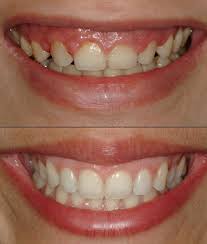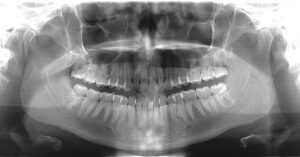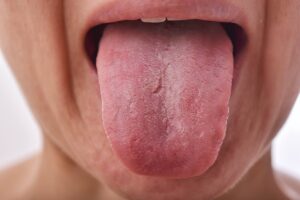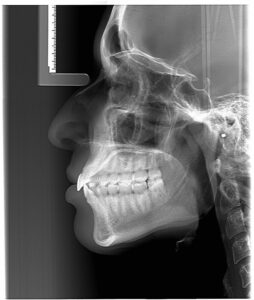Header logo
header top contact widget
Dental Technology
Reshaping Gum Tissues To Protect Oral Health & Enhance Smiling Appearance
Posted on Mar 21, 2024 by William J. Claiborne, DDS MS
When people think about the appearance of their smiles, it’s typically the teeth that are the focus. Everyone wants a smile that enhances appearance, instills self-confidence and gets compliments. Yet, the appearance of a smile involves more than just teeth. The “frame” of gum tissues that arch the teeth most visible in a smile have a lot to do with how a smile looks.
As a periodontal specialist in Asheville, NC, part of my specialty involves the treatment of all stages of periodontal (gum) disease, the placement of dental implants, and the contouring of gum tissues. Gum contouring is generally done for esthetic reasons but may also be advised for oral wellness.
Gums most often pull away from the base of teeth (or “recede”), exposing darker areas of the tooth. This darker area is part of the tooth’s root and highly vulnerable to damage. Recession also causes teeth to look longer and expose darker tooth root areas of the tooth. Being sensitive to hot or cold – causing a sudden jolt of pain – is often the final warning sign that the gums are not protecting tender root segments of the tooth.
Gum recession is commonly due to:
• Gum disease, which destroys gums tissues, causing them to loosen their firm grip around the base of teeth. This enables oral bacteria to penetrate beneath the gum line, reaching vulnerable bone and tissues.
• Over-vigorous toothbrushing can wear away precious gum tissues that surround the base of teeth. When using a back-&-forth scrubbing motion, or a hard toothbrush, gum tissues can be scrubbed off. Too, using abrasive substances to brush (such as baking soda) not only wear down gum tissues, they wear away tooth enamel.
• The aging process lessens hydration in the body. Because the gum tissues are moist layers that require continual hydration (supported by saliva), oral dryness can cause the gums to draw up as they become drier. Unfortunately, this creates more challenges in maintaining healthy teeth.
While gum recession is an oral health concern, it is a cosmetic issue as well. For an attractive smile, teeth should be arched by a balanced level and shape of gum tissues. When there is too much gum tissue showing above teeth or varying heights of gums arching teeth, the height and symmetry of gum tissues can be corrected by a periodontist.
For example, in a gummy smile, too much of the gum line is visible. This makes teeth look short and draws the eye to the gums rather than the teeth. Gum tissues should complement teeth with a balanced line of gum tissues. While a gummy smile is not generally problematic for one’s oral health, many people find it makes them “hold back” on smiling fully.

Before & After Of A Gummy Smile
The procedure to correct a gummy smile is a gingival lift, also known as a gum lift or gum contouring. This in-office procedure is performed to reduce and reshape highly visible gums.
In our Western NC periodontal dental office, we use a dental laser to perform a gingival lift. Our dental laser gives a precision line while only removing specific areas of the gums, leaving all surrounding tissue unharmed. This allows us to reshape the gums to create better balance in the smile.
A laser gingival lift also offers patients a more comfortable experience since it causes very little pain and therefore requires only topical anesthesia. In addition, laser treatments result in almost no bleeding and tissues tend to heal more quickly than after traditional surgery.
We also perform gum grafting that recovers areas where gum recession has occurred. This helps to protect the tooth roots and improves the appearance of the smile.
In gum grafting, we normally take a small area of tissue from the roof of the mouth and place it in the area of recession. When there is not sufficient tissue available, a graft may be from a donor source. The graft is attached to the natural gum tissue and gently sutured into the position where it corrects a smile’s appearance and reduces further recession and the potential for gum disease.
Several teeth may be involved in gum grafting when used to even out the gum line or reduce the risk of gum and bone collapse after a tooth has been lost. In these cases, cosmetic gum surgery is beneficial in reshaping excess gum and bone tissue. It also reduces sensitivity from exposed roots to hot or cold foods.
As a periodontist, I most commonly see gums that cover too much of the teeth as being due to genetics. When gums fail to cover sufficiently over the base of teeth, it’s typically the cause of recession, which can occur from several reasons (as listed prior). Regardless of why it has occurred, our goal is to provide the patient with the most healthy and esthetic outcome in a procedure that is comfortable, successful, and requires minimal healing time.
In our Asheville periodontal dental office, we offer some of the most advanced dental technology available. In addition to amazing imaging, such as Cone Beam 3D imaging, we provide Laser-Assisted New Attachment Procedure (or LANAP). This is a cutting-edge protocol to more efficiently and effectively treat periodontitis (advanced gum disease) with the PerioLase® MVP-7™ laser. Treatment is minimally invasive and helps to minimize both discomfort and recovery time. It has also been found to stimulate bone regrowth in damaged areas.
Additionally, our office offers both oral and I.V. sedation (“twilight sleep”) for complete relaxation during treatment. Sedation is administered safely by a doctor of anesthesia to provide optimal safety and comfort.
If finances have kept you from seeking out the care you need or the beautiful smile you desire, feel free to contact our friendly staff and arrange a consultation appointment. During this time, we can discuss the best options for you, cost estimates, and predicted treatment time.
We can also review several payment plans that make treatment affordable through extended, interest-free payment periods with no down payment required. These often help our patients enjoy their confident, new smiles while making easy monthly payments that are budget friendly.
Call 828-274-9440 to schedule.
How A Periodontist Can Help Cancer Patients
Posted on Mar 18, 2024 by William J. Claiborne, DDS MS


As You Age, Avoid A ‘Melting’ Face With Dental Implants
Posted on Feb 26, 2024 by William J. Claiborne, DDS MS
It seems the older one gets, the more conscious he or she is to the need for good health practices. While periodic exams and check-ups are part of this, eating healthy and getting ample exercise are practical ways to support a healthy body.
The same principles apply to oral health. While annual physical exams are needed, regular check ups and dental hygiene cleanings are as well. Through decades of research, “bad” bacteria in the mouth can lead to inflammatory reactions that can offset or worsen a number of health problems far beyond the mouth.
For now, let’s focus on your gum health and the presence of teeth. While natural teeth are the ideal structure for biting, chewing and speaking, the rigors of age – the natural wear and tear – can take its toll on teeth. Decay, gum disease, accidents and certain illnesses can lead to losing a tooth or teeth over the span of a lifetime.
There are several ways to replace a missing tooth (or teeth). A crown-&-bridge is a longstanding method to replace one or several teeth in one area. Or, a partial denture can replace a “scattering” of teeth in the same arch. However, the downside of these oral prosthetics is what’s beneath the gum line.
Your natural teeth are supported by your upper and lower jaw bone, known respectfully as the maxilla and mandible. With these strong, study bones, tooth roots are held securely. Thus, biting and chewing occurs comfortably.
The jaw bones are actually kept healthy by the presence of tooth roots. These roots provide stimulation to the bone as well as nourishment that feeds through the tooth’s interior.
When a tooth is removed, so is the stimulation and nourishment to that area of the jaw bone. Without it, the bone begins to shrink. As it declines in height, the adjacent teeth are more vulnerable to loss. Statistics show that teeth adjacent to areas where natural teeth are missing will be the most likely to be lost next.
This has a domino effect. Partials can replace the presence of teeth above the gum line, but there is nothing to benefit the jaw bones below. Thus, tooth loss continues and can go from a few missing teeth to losing all teeth (being “edentulous”).
According to the Center for Disease Control & Prevention (CDC), 69 percent of adults between the ages of 35 – 44 have lost at least one permanent tooth. By age 50, Americans are missing an average of 12 teeth. For adults between the ages of 65 – 74, 26 percent are missing all of their natural teeth. That’s over one-fourth of the adult population over age 65.
Although dentures and partials mimic the presence of teeth, the jaw bones below are shrinking away, and at a rather rapid pace. The pressure of wearing a denture or partial actually speeds this process up, known as “resorption.”
As these bones decline in mass, deep wrinkles form around the mouth. The corners of the mouth turn downward. The chin takes on a more pointed form and the mouth sinks into the face. The nose seems to get closer to the chin as the jaw bones thin. Jowls form as facial muscles detach from shrinking bone structure.
Changes in facial appearance also take place when bone structures shrink. For example, as the jaw bone thins, deep wrinkles form around the mouth. The corners of the mouth will start to turn down, even in a smile. Jowls form on each side of the face as facial muscles detach from the shrinking bone structure.
As the jaw bone declines further, the chin becomes more pointed and the nose seems to get closer to it. This leads to a collapsed mouth that is known as a “granny look.” This look ages the appearance of an individual far beyond their actual years.
Not to be overlooked is the ability to comfortably bite and chew food. This is essential for the digestive process, since the first stage of digestion begins in the mouth. When adults struggle to eat with a denture or partial, the efficiency of this initial stage of digestion is compromised.
It’s not unusual for adults who have “rocky” or “slippery” dentures to opt for soft foods that dissolve easily in the mouth. These are often carb heavy and lack the nutritional value of a diet that combines healthy proteins, fruits and vegetables.
However, missing teeth or dentures that move when eating can cause other detrimental problems. When people sense their dentures may cause embarrassment when eating, speaking or laughing with others, social involvement can take a hit. According to a 2012 statement by the World Health Organization:
“Oral health is essential to general health and quality of life. It is a state of being free from mouth and facial pain, oral and throat cancer, oral infection and sores, periodontal (gum) disease, tooth decay, tooth loss, and other diseases and disorders that limit an individual’s capacity in biting, chewing, smiling, speaking, and psycho-social well-being.”
As an Asheville periodontist, my dental specialty includes the diagnosis and placement of dental implants. Dental implants are the closest thing to natural teeth.
Dental implants were designed to recreate the presence of natural teeth both above and below the gum line. Because teeth attached to the implants are supported by the jaw bone, the study foundation restores the ability to bite and chew without movement or fear of embarrassing slips.
For patients who are missing a great deal of bone, we offer bone rebuilding that does not require a bone graft. We also perform sinus lifts (when the upper jaw has declined to a significant level) to restore sufficient bone distance between vital structures.
For many of our dental implant patients, their lives become more active with the restored confidence. They become more socially involved, have more self-confidence and higher self-esteem. And the advantages of dental implants over other tooth replacement options are numerous.
• Dental implants are designed to last your lifetime. They do not decay, need root canals or compromise neighboring teeth or bone structure.
• Because dental implants are positioned in the jaw, they recreate stimulation to the bone. This helps to preserve the bone’s mass, halting the pace of jaw bone shrinkage (known as resorption).
• Resorption is what causes changes in one’s facial appearance, aging one’s appearance far older than their actual age.
• Dental implants do not move or slip when eating, speaking or laughing. A denture is designed to fit the contours of one’s gum ridge; contours that exist at the time the denture is made. However, as resorption reduces bone height, the ridge that holds the denture flattens out over time. This is why a denture becomes ‘wobbly’ or ‘slippery.’
• Dental implant treatment is largely determined by the number of implants placed. In most cases, one implant can support more than one tooth. A full arch (all upper or lower) of teeth are typically supported by several strategically-placed implants.
• Unlike a crown-&-bridge, dental implants so not need the support of adjacent teeth. Therefore, it is not necessary to have teeth shaved down for crowning simply to serve as supports for a bridge.
In our Asheville periodontal dental office, we have highly-advanced technology that aids in the diagnosis and placement process of dental implants. These features help to enhance patient comfort, shorten treatment time, and provide optimal results. Advanced technology includes:
– Computerized Dental Implant Placement – an advanced system for pre-surgical positioning of dental implants using a 3D model of the patient’s jaw. Once the implant type is selected, a template is developed for optimal treatment success.
– Cone Beam Imaging – is ideal for diagnoses and treatment planning through images that provide a clear view of the upper and lower jaw (including nerve canals), with rotations that show sagittal, axial, and coronal planes in a process that is quick, painless and at minimal radiation levels.
– Dental Laser – This small, hand-held device is a tremendous asset when it comes to both the health and appearance of gum tissues. Not only does the laser eliminate or greatly minimize bleeding during procedures, it reduces numbing requirements, removes bacteria and easily uncovers gum tissue where dental implants have been placed. Additionally, laser dentistry can beautifully re-contour or repair gum tissue with a precision line.
As a periodontal specialist serving Western NC, I take great pride in the diagnosis and placement of dental implants with each selected based upon the patient’s individual needs and goals. We provide oral or I.V. sedation to ensure a comfortable experience and a friendly, respectful environment.
To schedule an examination appointment or to begin with a consultation, call 828-274-9440. A referral is not always necessary.
Do Different Age Groups Perceive the Importance of Oral Health Differently?
Posted on Feb 09, 2024 by William J. Claiborne, DDS MS
Just how important is your oral health?
Although Americans often focus on their smiles esthetically, it’s a far more important part of you than is often given due credit on a day-to-day basis. Yes, straight, white teeth help to enhance the appearance of a smile (as well as facial appearance), it’s what is typically not seen that has far greater importance.
About 50% of the world’s population over the age of 30 suffer from periodontitis. In the U.S., a developed country with excellent healthcare, a whopping 47% of adults over the age of 30 have some level of periodontal disease.
Because gum disease can begin without obvious symptoms, or be present without having pain, it is too easily ignored. This allows the disease to progress further.
The early stage, known as gingivitis, usually begins with swollen and tender gums that bleed easily when brushing teeth. As it worsens, the healthy pink hue of gums darken to more of a red color and breath odor is persistently bad. The gums begin to loosen their strong grip around the base of teeth, allowing infectious bacteria to reach bone structures that support tooth roots. In advanced stages (periodontitis), pus pockets form near the base of some teeth and gums become spongy in texture.
The bacteria of periodontal disease doesn’t just damage oral health. Through weakened oral tissues, the bacteria can enter the bloodstream and trigger inflammatory reactions. These reactions can worsen some serious health conditions and even activate others.
Research has found correlations between these bacteria and heart disease, stroke, diabetes, arthritis, some cancers (including pancreatic), preterm babies, erectile dysfunction, and Alzheimer’s disease.
In a 2020 study, individuals with gum disease who contracted COVID-19 were 9 times more likely to die. And, the study showed that COVID patients who already had advanced gum disease were 3 times more likely to end up in intensive care or on a ventilator. Evidence shows that poor oral health can increase viral infection severity, and even fatality rates.
But, does age play a part in the commitment to oral health?
A report commissioned by Delta Dental Plans Association revealed some concerning information regarding age groups and perceptions of oral health. With over 1,000 online participants, 87% listed their priority for maintaining proper oral care was to save money or avoid unexpected expenses. Two-thirds of the group listed their commitment to at-home dental hygiene as the desire to avoid tooth decay and gum disease. Yet, only 79% of adults stated they brushed their teeth twice a day with only 33% admitting to flossing daily.
In reviewing age groups, the report found that baby boomers (those born between 1946 – 1964) understand there is a strong link between their oral and overall health, but are less aware than other generations about the connection between poor dental health and chronic diseases (such as arthritis and diabetes). Those listed in the Generation Z group (born between 1997 – 2012) showed less commitment to their oral health as the “boomers,” but are more focused on eco-friendly and nontraditional oral care products. Only 76% of Generation Z agreed that oral health is closely connected to overall health.
An article in RDH Today recently shared that one-third of millennials (born between 1981 and 1996) admit to only brushing once per day, and the average millennial has gone over two days without brushing at all. Yet, 28% of young adults admit that ““The appearance of my mouth and teeth affects my ability to interview for a job.”
The study also shared that 27% of millennials are uncomfortable going to the dentist compared to 23% of respondents 55 years and older, and 56% of millennials have simply made an excuse not to go to the dentist compared to the 36% of those 55 years and older.
While fear remains a factor in a percentage of adults, this deterrent has existed for years among all ages. The American Dental Association conducted a survey on millennials, the fear issue was not the leading problem. Cost and inconvenient time and location were cited as the top excuses for avoiding regular dental care.
Excuses aside, here are some reminders about the benefits of maintaining good oral health:
• Technology – Today’s imaging technology (such as our Cone Beam technology and IntraOral scanners), allow us to treatment plan for the most conservative treatment possible. These amazing features provide amazing detail so treatment can be performed with precision for optimal outcomes.
• Comfort – In addition to the conservative treatment made possible by advanced imaging technology, we offer enhanced comfort options, including oral and I.V. sedation. Also referred to as “twilight sleep” or “sleep dentistry,” these sedatives are administered by a doctor of anesthesia who utilizes advanced safety monitoring equipment.
• Savings of Time & Money – The reason for 6-month dental check-ups and dental cleanings is to remove tartar buildup before damage can occur. Your hygienist and dentist can look for signs of gum disease so measures can be taken before the disease explodes into the need for more costly treatment to resolve the problem. Since gum disease is the nation’s leading cause of adult tooth loss, the associated expenses of replacing teeth can also be avoided by maintaining good oral health.
• Bolstering Overall Health – Although the Covid pandemic made us more aware of the benefits of vaccines and healthy habits such as hand-washing, it is our immune system that makes people more or less vulnerable. By investing in having healthy gums, the immune system is supported.
Be aware of the signs and symptoms of gum disease. These include:
Sore, swollen gums
Gums that bleed easily when brushing
Persistent bad breath
Gums that recede (pull away or loosen from the base of teeth)
Gums that turn red in color
Pus pockets that form at the base of some teeth
Teeth that loosen or shift
If you have any of these, you are urged to seek periodontal care as soon as possible. This disease will only worsen without treatment.
Call 828-274-9440 to schedule a consultation in our state-of-the-art Asheville periodontal dental office. A referral is not required.
Sources:
https://onlinelibrary.wiley.com/doi/10.1111/jcpe.13435https://www.cdc.gov/nchs/fastats/dental.htm
https://www.todaysrdh.com/do-millennials-truly-have-worse-oral-health-than-their-parents/
https://nypost.com/2018/02/23/millennials-are-terrible-at-keeping-their-teeth-clean/
Recent Posts
Categories
Archives
- September 2024
- August 2024
- July 2024
- June 2024
- May 2024
- April 2024
- March 2024
- February 2024
- January 2024
- December 2023
- November 2023
- October 2023
- September 2023
- August 2023
- July 2023
- June 2023
- May 2023
- April 2023
- March 2023
- February 2023
- January 2023
- December 2022
- November 2022
- October 2022
- September 2022
- August 2022
- July 2022
- June 2022
- May 2022
- April 2022
- March 2022
- February 2022
- January 2022
- December 2021
- November 2021
- October 2021
- September 2021
- August 2021
- July 2021
- June 2021
- May 2021
- April 2021
- March 2021
- February 2021
- January 2021
- December 2020
- November 2020
- October 2020
- September 2020
- August 2020
- July 2020
- June 2020
- May 2020
- April 2020
- March 2020
- February 2020
- January 2020
- December 2019
- November 2019
- October 2019
- September 2019
- August 2019
- July 2019
- June 2019
- May 2019
- April 2019
- March 2019
- February 2019
- January 2019
- December 2018
- November 2018
- October 2018
- September 2018
- August 2018
- July 2018
- June 2018
- May 2018
- April 2018
- March 2018
- February 2018
- January 2018
- December 2017
- November 2017
- October 2017
- September 2017
- August 2017
- July 2017
- June 2017
- May 2017
- April 2017
- March 2017
- February 2017
- January 2017
- December 2016
- November 2016
- October 2016
- September 2016
- August 2016
- July 2016
- June 2016
- May 2016
- April 2016
- March 2016
- February 2016
- January 2016
- December 2015
- November 2015
- October 2015
- September 2015
- August 2015
- July 2015
- June 2015
- May 2015
- April 2015
- March 2015
- February 2015
- January 2015
- December 2014
- November 2014
- October 2014
- September 2014
- August 2014
- July 2014
- June 2014
- May 2014
- April 2014
- March 2014
- February 2014
- January 2014
- December 2013
- November 2013
- October 2013
- September 2013
- August 2013
- July 2013
- June 2013
- May 2013
- April 2013
- March 2013
- February 2013
- January 2013
- December 2012
- November 2012
- October 2012
- September 2012
- August 2012
- July 2012
- June 2012


